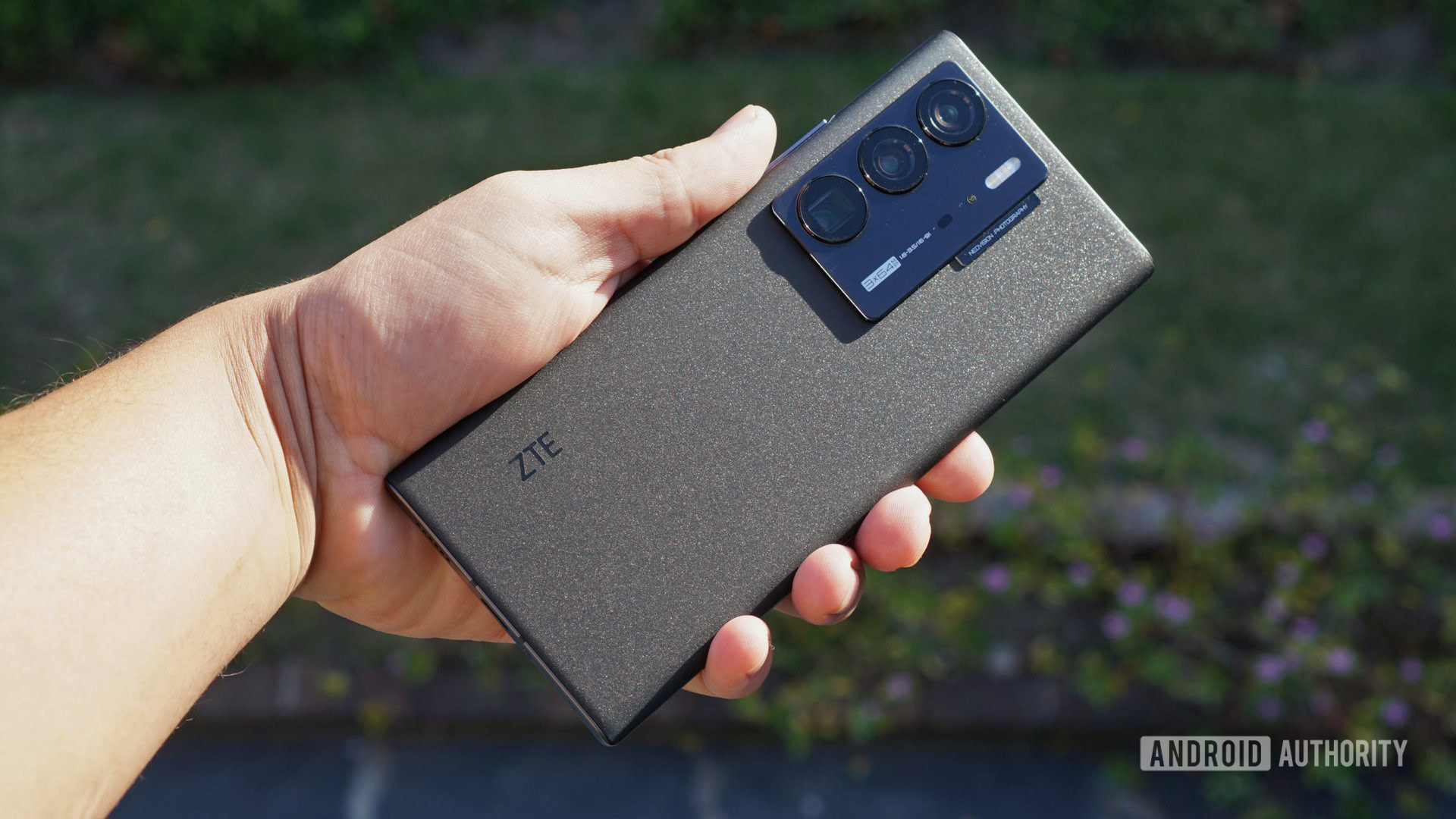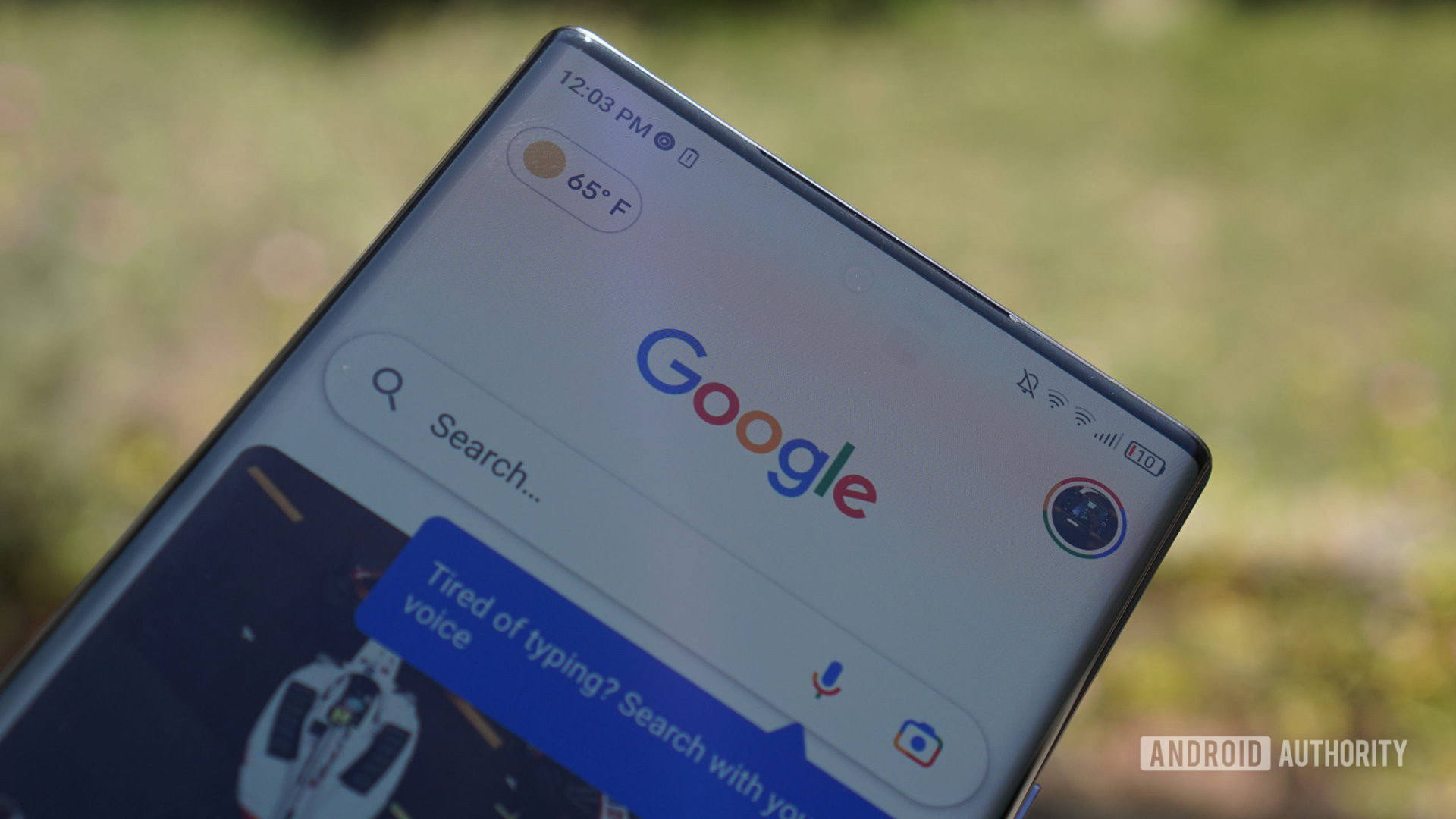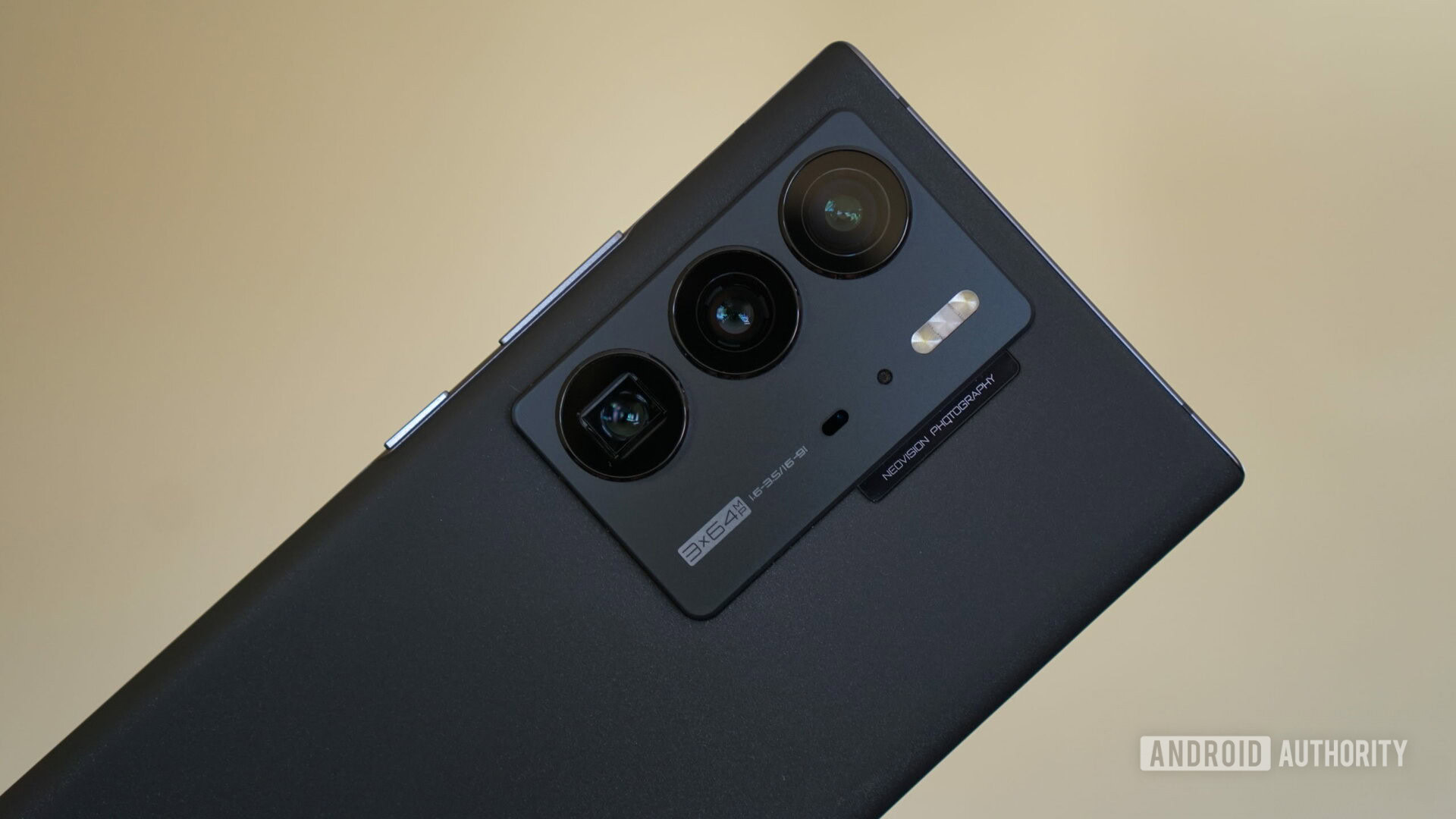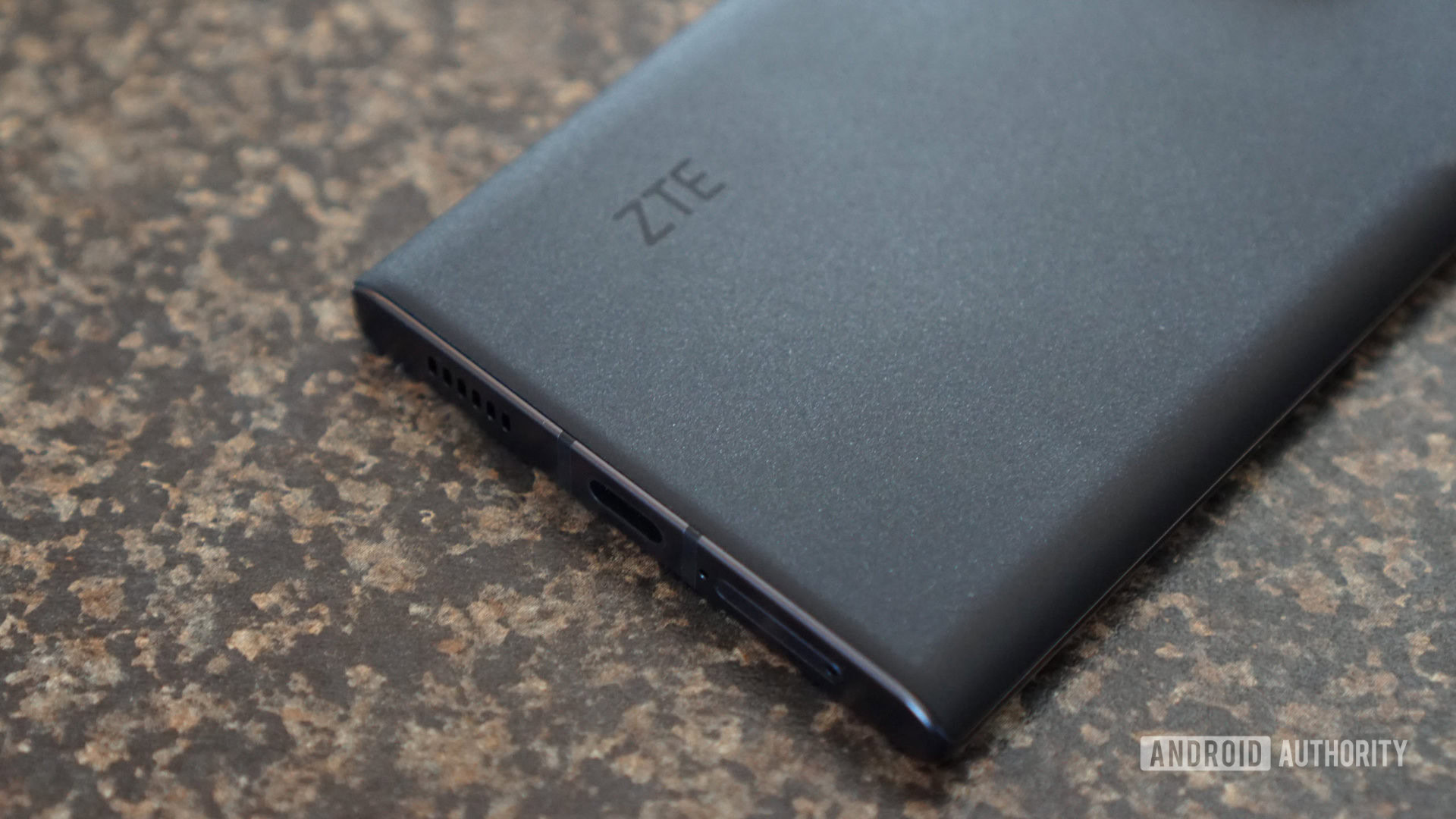The ZTE Axon 40 Ultra is a powerful, long-lasting, fast-charging phone that swaps some premium extras for an innovative under-display camera, though the lack of flagship polish and an update promise doesn’t always feel like a fair trade.
ZTE has been pioneering under-display selfie cameras since 2020 with its Axon series. Now, the Chinese brand is back with the Axon 40 Ultra, equipped with a new generation of under-display selfie camera tech while delivering flagship-tier specs and features. Is this the ZTE phone that will take the fight to high-end offerings from Google, Samsung, and Apple? Find out in our ZTE Axon 40 Ultra review.
What you need to know about the ZTE Axon 40 Ultra
Hadlee Simons / Android Authority
- ZTE Axon 40 Ultra (8GB/128GB): $799 / £709 / €829
- ZTE Axon 40 Ultra (12GB/256GB): $899 / £809 / €949
The ZTE Axon 40 Ultra is a flagship-level smartphone that’s the top-end device in ZTE’s portfolio for 2022 so far. It’s a successor in some ways to last year’s Axon 30 Ultra, offering a brand-new flagship SoC and a bigger battery. But it also steps back in a couple of ways, with a shorter range zoom camera and dropping ever so slightly from a 144Hz display to 120Hz.
Otherwise, you’re getting some premium specs, such as the much-hyped under-display selfie camera, a triple 64MP rear camera system, and a 5,000mAh battery with 65W wired charging.
ZTE’s smartphone launched in China in May 2022 before a global launch on June 8 with general availability from June 21. These global markets include Asia-Pacific, Europe, the Middle East, North America, and South Africa. It comes in Black (pictured), Gold, or Silver colorways.
What’s good?

Hadlee Simons / Android Authority
The Axon 40 Ultra sports a premium, if quite slippery, design featuring a brushed glass back and a sizeable camera bump. The former means fingerprints aren’t a concern at all, although the latter does make for plenty of wobbling when flat on a table. I also somehow scuffed the glass back during testing, which isn’t a great sign considering I didn’t drop it. Regardless, you’ll want to slap on the included TPU case or buy another case as it’s quite slippery in the hand.
The ZTE Axon 40 Ultra looks like a premium offering, while the under-display selfie camera makes for an uninterrupted screen.
The most striking design choice is the lack of a punch-hole selfie cutout, pop-up camera module, or notch. That’s right; you’ve got an uninterrupted display here thanks to the in-display selfie camera. I found that the camera wasn’t visible most of the time, though you’ll notice a very slight smudge every now and again whenever the screen shows gray shades and blurred backgrounds. You can also see the sensor itself if you specifically look for it in direct sunlight, but it mostly melts into the background and doesn’t present any haziness on the display. It’s certainly a big step up from the obvious under-display camera blob on the Galaxy Z Fold 3.
Dive under the hood and you’ll find the Axon 40 Ultra’s core specs can rival the very best thanks to the Snapdragon 8 Gen 1 SoC, 8GB to 12GB of RAM, and 128GB or 256GB of storage. Benchmark results show both the 3DMark Wild Life and Geekbench 5 three-run average scores were on the lower end of the Gen 1’s performance charts, but still will within expectation for an elite Android flagship.
Fortunately, the Axon 40 Ultra generally holds up well when it comes to real-world usage. Flicking through home screens, launching apps, and scrolling was a fluid experience, while performance during camera usage was mostly smooth bar a few software gremlins (more on that later). The Axon 40 Ultra deftly handled demanding games like Call of Duty Mobile, Genshin Impact, and Apex Legends. You’re not going to get a buttery smooth experience in Genshin Impact by turning everything to maximum, but that’s par for the course for all Android flagships anyway.
There isn’t a ton of bloatware on the phone, and what is present — a generic Browser app, Booking.com, and Facebook — can be removed. There’s also a ZTE Cares support app and a file manager. Otherwise, first-party apps are otherwise eschewed in favor of Google-backed options. That means Google Photos, YouTube Music, Gmail, and other Google apps instead of redundant OEM equivalents.
The Axon 40 Ultra has the performance and battery longevity of a top Android flagship.
The ZTE Axon 40 Ultra is equipped with a 5,000mAh battery and it indeed delivers a healthy level of endurance, with an average of over seven hours of screen-on time in our testing. Even with heavy use — several hours of GPS navigation, an hour of YouTube, and some games — and with the automatic refresh rate option enabled, the phone didn’t stop going until about 10 AM the next day. I was also able to get about eight and a half hours of screen-on time with light usage over two days (YouTube, Telegram, only a few minutes of gaming).
Once the battery hits zero, you can take advantage of 65W wired charging support. Best of all, this charger is included in the box and supports USB PD PPS for charging your other gadgets too. The Axon 40 Ultra took just 41 minutes to go from zero to 100% capacity, hitting 63% after 20 minutes.
The Axon 40 Ultra is also packing a 6.8-inch 120Hz FHD+ OLED screen that isn’t quite cutting-edge anymore but still delivers a pleasant viewing experience. I had no problem using the device in direct sunlight, while colors seemed accurate to the eye and the temperature leaned on the warmer side. You can also tune the colors with a three-stage slider (colorful, standard, soft) and adjust the temperature using a three-stage slider or a more granular tool.
What’s not so good?

Hadlee Simons / Android Authority
There are a few areas where ZTE could’ve delivered more polish, with the under-display selfie camera perhaps being the biggest problem. Simply put, this hidden 16MP shooter might be innovative, but as an actual front-facing camera, it can’t hold a candle to mid-range phones and older flagships, let alone recent high-end phones.

Hadlee Simons / Android Authority
A portrait selfie.
Even pictures taken in ideal conditions can see smeared hair and plenty of noise, along with a vaseline effect that’s only more pronounced in indoor and backlit scenes. Portrait selfies are also raw, let alone half-baked. ZTE is resorting to beautification by default, presumably to draw attention away from the obvious cutout errors and smeared look.
It really says a lot about the state of under-display cameras that ZTE is on its third generation of the tech and images still look worse than many budget phones, despite the brand’s claims that image quality is “vastly improved.” Check out the next section for our thoughts on the rest of the Axon 40 Ultra’s cameras.
Related: The best selfie camera phones
Software can make or break powerful hardware, but it must be said that ZTE’s My OS isn’t the most memorable Android skin by any measure. It looks and feels like stock Android in several areas (no bad thing), although the default color scheme recalls Apple’s iOS. Fortunately, you can customize things such as the notification shade colors and icon shapes. Ultimately though, it doesn’t have as many features as the likes of One UI and MIUI.
The biggest software disappointment, however, is the apparent lack of an extended update pledge. We’ve seen the likes of Google and Samsung up the ante with up to five years of security patches, but ZTE hasn’t gone on record about long-term support for its latest flagship. Considering the Axon 30 was only promised one version upgrade and no set timeframe for security patches, this is quite concerning. We’ve asked ZTE to clarify the situation and will update as we hear back.
While the Axon 40 Ultra has a generally good screen, it’s not the best out there. The most notable issue is that it isn’t a battery-efficient LTPO panel like similarly-priced rivals, and the refresh rate only switches between 60Hz and 120Hz in adaptive mode. This is also a curved screen and I found the touch rejection to be too aggressive, sometimes requiring a longer, more deliberate upward swipe to close an app on the edge of the recents menu.
The Axon 40 Ultra misses out on a few premium extras that rival devices have.
It also lacks the polish of the very best Android phones on the market. The ZTE Axon 40 Ultra in-display fingerprint sensor is another aspect that left us wanting, offering a few more reading errors and being a little bit slower compared to other phones with in-display scanners. Additionally, ZTE’s latest flagship doesn’t support wireless charging or have an IP rating, two things you would fairly take for granted at this price point.
ZTE Axon 40 Ultra camera review

Hadlee Simons / Android Authority
Out and about and want to take some snaps? Then you’ll be glad to know that the Axon 40 Ultra’s 64MP (35mm equivalent) main camera does an excellent job during the day. The dynamic range isn’t nearly as wide as some of the best camera phones but it’s still solid. Colors fall on the realistic side, and reliable focusing means consistently sharp images. It doesn’t hurt that the camera app usually delivers clean images that don’t go overboard with the sharpening.
The ultrawide lens is capable of some eye-pleasing, detailed results during the day as well, using the same IMX787 sensor as the main camera. However, colors are noticeably inconsistent between the two cameras, noise is easy to spot in the shadows, and it’s not uncommon to find mushiness at the edge of pictures. At least this camera has autofocus, allowing it to take some sharp macro mode shots.
When night comes, you’ll find that neither the primary camera nor the ultrawide sensor can hang with the best of them. You’ll notice plenty of noise and a dark image when the sun goes down, with the ultrawide being much worse off. Thankfully, the night mode is a truly transformative affair here, clawing back noise, increasing the brightness, and retaining some detail to deliver some good images. Low-light snaps taken with the ultrawide camera are also very soft, but the night mode helps here too.
The third camera here is a 64MP periscope lens, and it’s only equivalent to ~2.6x zoom (or 3.5x compared to more conventional primary cameras). The color profile predictably doesn’t line up with the main camera, but it nevertheless delivers a good level of detail and offers usable images up to about 4x or 5x. Any longer-range zoom is a no-go due to blown-out highlights, blurry edges, and a watercolor effect.
Video quality is pretty solid here too, featuring punchy colors and generally effective stabilization. However, I did notice a fair amount of frame-rate judder now and again in both 4K/60fps and 8K modes. The lack of a dedicated super steady mode is also lamentable here when other brands all offer this option. There are a wide variety of video quality options though, including 8K, 4K/60fps, 4K/120fps, 1080p/240fps, and 720p/480fps.
The Axon 40 Ultra’s main camera takes some great shots during the day, and there are loads of interesting modes on offer.
Speaking of variety, those who value a smorgasbord of modes will like what they see here, as the Axon 40 Ultra’s camera app comes with plenty to choose from. Aside from the expected pro/manual, night, portrait, macro, and timelapse options, you’ve also got a vlog option, full-resolution mode, document scanner, and the aforementioned slow-mo options. You’ve also got an electronic shutter option (basically a bokeh mode), multi-exposure mode (overlaying two exposures in one image), a clone mode, Hitchcock zoom option, drama shot-style trajectory mode, a few light painting options, and a starry sky mode for astrophotography. The latter includes options like constellation overlays using augmented reality, which is something I haven’t seen in an OEM camera app before.
One of my favorite modes has to be the multi-camera option though, allowing you to take shots from all three rear cameras at once. It’s not perfect, as the zoom lens often has focusing issues, but it’s still a swell time-saver. You can also place a different camera in the primary viewfinder, so if you want the telephoto lens in the primary viewfinder and the ultrawide and 1x camera in the smaller windows, you can do that too.
While we appreciate the number of camera features on board here, the camera app does need some polishing. For example, we encountered some freezing in the viewfinder when wanting to review the most recently taken photos. We also found that the camera app crashed without fail when switching to the video option and then choosing the tele lens. Zoom controls aren’t always consistent, either. Shooting with the standard mode gives you zoom controls just above the camera mode carousel (e.g. a “1x” icon flanked by icons for wide and tele cameras), but switching to the Night and Pro modes sees separate zoom controls placed on the left-hand side (when held in portrait). The “1x” icon is still above the camera mode carousel, but you can’t actually tap it to switch between cameras — check out the last image in the gallery above.
The Axon 40 Ultra camera app has loads of features, but it needs an overhauled design and more polish.
It’s also possible to record videos from multiple cameras at once, and it’s a feature we’ve wanted to see on more phones since Xiaomi did it with the Mi 11 Ultra. Unfortunately, it looks like the Axon 40 Ultra’s mode needs improving too. We don’t mind that the quality is limited to 1080p/30fps (or 24fps at times), but what’s the point of sacrificing resolution when the frame rate is extremely choppy?
It also doesn’t help that the camera UI feels like it hasn’t been updated since 2014. ZTE could easily roll some of the more experimental features (like the three light painting modes) into one, and more generally could make much better use of the viewfinder to host frequently used settings for quick access.
ZTE Axon 40 Ultra specs
| ZTE Axon 40 Ultra | |
|---|---|
|
Display |
6.8-inch QHD+ |
|
Processor |
Qualcomm Snapdragon 8 Gen 1 |
|
RAM |
8/12GB |
|
Storage |
128/256GB |
|
Battery |
5,000mAh |
|
Cameras |
Rear:
64MP standard at f/1.6, OIS (35mm) 64MP ultrawide at f/2.35, autofocus (16mm) 64MP ~2.6x periscope camera at f/3.5, OIS Video: 8K at 30fps, 4K at 30/60/120fps, 1080p at 30/60/120/240/960fps, 720p at 480/1920fps Front: 16MP under-display selfie camera |
|
IP rating |
N/A |
|
Headphone jack |
N/A |
|
Connectivity |
IR blaster |
|
Software |
MyOS 12 |
|
Dimensions and weight |
163.28 x 73.56 x 8.41mm |
ZTE Axon 40 Ultra review: The verdict

Hadlee Simons / Android Authority
The Axon 40 Ultra gets most of the basics right, delivering a high-powered, long-lasting smartphone that tops up in under an hour. The addition of versatile rear cameras and that full-screen experience enabled by a stealthy under-display selfie camera means you’ve got an intriguing yet capable proposition at a very reasonable asking price.
However, it’s clear that there are a few gaps in the Axon 40 Ultra’s armor, starting with those disappointing selfies. Even at a more affordable flagship price, just shy of $800 is a tough ask for a phone that lacks an IP rating and wireless charging. There are a few alternatives on the market that come in at the same price or undercut the ZTE device while offering these extras.
The ZTE Axon 40 Ultra is a powerful, long-lasting, fast-charging phone at an affordable price, but it lacks some flagship polish.
Speaking of alternatives, we’d definitely recommend you look at the Google Pixel 6 ($599). For $200 less, you can get a relatively powerful smartphone with great image quality, a long commitment to updates, Pixel-exclusive software features, a relatively large battery, and that IP68/wireless charging combo. It lacks the beefy Snapdragon 8 Gen 1 chipset, telephoto camera, and fast charging though. Meanwhile, for an extra $100, the Google Pixel 6 Pro ($899) adds that missing zoom camera, ups the display refresh rate and resolution, and packs an even larger battery.
The Samsung Galaxy S22 ($799) is another alternative worth investigating, and it’s probably the most widely available alternative on the list. It packs the same chipset, an extended update pledge, more software features, an IP68 rating, and wireless charging. You do miss out on fast charging and that 3,700mAh battery has us concerned about how it’ll hold up over time.
Check out: The best phone deals
The OnePlus 10 Pro ($899) might be another device you should consider in lieu of the Axon 40 Ultra. It doesn’t have an under-display selfie camera and costs $100 more, but you’re getting perks like wireless charging, a good primary camera, a superior screen, and three years of OS updates. It also shares a few of the Axon 40 Ultra’s strengths such as battery life, fast charging, and the same powerful processor, though it’s a little rough around the edges due to the similarly lacking IP rating (unless you buy from T-Mobile), mediocre supporting cameras, and some software inconsistencies.
You should also keep the iPhone 13 ($799) in mind if you’re open to joining the Apple ecosystem. It lacks a high refresh rate screen, has a massive notch, lacks a telephoto camera, and misses out on fast charging (and the charger). However, Apple’s phone also brings a powerful processor, IP68 rating, wireless charging, and access to an exclusive ecosystem.

ZTE Axon 40 Ultra
The ZTE Axon 40 Ultra is a powerful, long-lasting, fast-charging phone with an innovative under-display camera.
Top ZTE Axon 40 Ultra questions and answers
The phone doesn’t have an IP rating, so there’s no official water resistance rating.
No, the Axon 40 Ultra does not have a 3.5mm headphone jack. You’ll need to use the USB-C port or Bluetooth.
Yes, the Axon 40 Ultra will be available to buy in the UK, as well as selected regions across the rest of Europe.
Yes, the Axon 40 Ultra comes with a 65W charger in the box.

